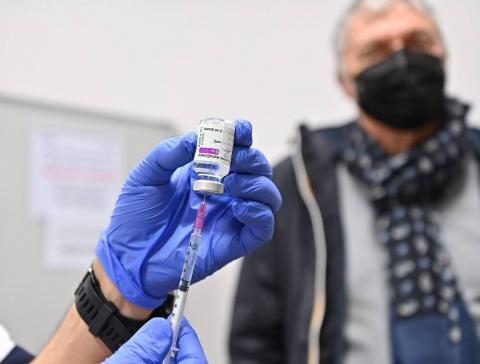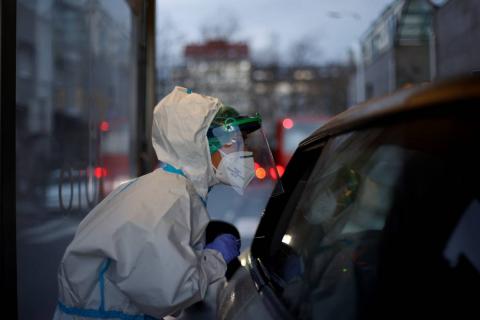Reactions to the announcement that face masks will no longer be mandatory indoors from 20 April
The Minister of Health, Carolina Darias, today announced that face masks will no longer be compulsory indoors after Easter. The measure will come into force on 20 April. It will continue to be compulsory in public transport, health centres and residences, but the final details of the new scenario are not yet known.

The risk of covid-19 transmission is much higher indoors than outdoors / Adobe Stock
Voro Peiró - mascarilla interiores
Salvador Peiró
Epidemiologist, researcher in the Health Services and Pharmacoepidemiology Research Area of the Foundation for the Promotion of Health and Biomedical Research of the Valencian Community (FISABIO) and Director of Gaceta Sanitaria, the scientific journal of the Spanish Society of Public Health and Health Administration (SESPAS)
The withdrawal of the obligation to wear face masks indoors after Easter seems reasonable in the current epidemiological scenario. Provided that the exceptions and nuances proposed in the draft of the Alerts Report that has been circulating these days are taken into account. And provided that hospitalisation figures do not rise again in the next two weeks.
I think it is important to emphasise the situations in which the Paper recommends (not only those in which use is mandatory) the continued use of face masks indoors. In this sense, it would be of interest for the Ministry and the Autonomous Communities to carry out a social communication campaign to inform the population of the importance of these recommendations (also the recommendations associated with isolation).
With the "end of the pandemic" sound of the withdrawal of measures (and the way they are communicated), it is foreseeable that there will be very little adherence to the mandatory and recommended measures. And with current levels of transmission, adherence to recommendations is still very important.
Óscar Zurriaga - mascarilla interiores
Óscar Zurriaga
Professor of Preventive Medicine and Public Health at the University of Valencia and outgoing president of the Spanish Society of Epidemiology (SEE).
The situation of the covid-19 pandemic is now more favourable than it was just a few weeks ago, but it is worth remembering that it is not yet over and that virus transmission persists. The new surveillance strategy has only been in place for a fortnight and, although it is possible to have the time series of indicators covered by the strategy for a much longer period than 15 days, it is still a little premature to make a full assessment. From what we know of these indicators, there is territorial heterogeneity and, in general, a certain stabilisation has been observed over the last month or so. It is true that the most serious indicators are at low levels.
In the next two weeks we will have more elements to assess the situation in a much better way and it is possible that the situation has evolved in a way that allows different measures to be taken. But it is also possible that the upcoming mobility, due to Easter and other events, will indicate that the situation is different.
That is why the announcement of the withdrawal of facemasks indoors on a certain date, without knowing a priori what the situation will be like at that time in the near future, cannot be a measure based on the evidence of the epidemiological situation at that time, but on other issues. These other aspects must also be taken into account, of course, but they need to be made explicit when the decision is taken so that it is understood by the public.
The use of face masks indoors is a very iconic and visible measure, and its elimination also sends the message that there is no longer any need for any measure. It should be remembered that the new surveillance strategy is based on the need to focus protection on vulnerable people and, for this to be effective, it is essential that some measures are maintained in the areas where vulnerable people live, work and reside. Part of its success lies in those who are not vulnerable protecting those who are vulnerable by their behaviour and compliance with these minimum measures.
It would be highly desirable to maintain the use of face masks indoors in certain situations, as well as other measures that tend to be forgotten, such as ventilation and avoiding crowds in enclosed spaces, based on the need to protect vulnerable people. It would therefore also need to be very well established, and better explained, under what circumstances the use of face masks indoors should be more than just a recommendation.
Adrián Aginagalde - mascarillas interiores
Adrian Hugo Aginagalde
Spokesperson of the Spanish Society of Preventive Medicine, Public Health and Health Management (SEMPSPGS), Head of Service of the Epidemiological Surveillance and Health Information Unit of Gipuzkoa and, previously, Head of Service of the Population Screening Programmes Unit at the Ministry of Health
Before the start of vaccination, 10% of cases required hospitalisation; in the latest wave, 2.4%, and case fatality has dropped from 1% to 0.1%. In other words, vaccination and the Omicron have reduced the severity and measures need to be reassessed. Despite this, the healthcare impact of SARS-CoV-2 is still three times that of influenza and the percentage of hospitalisations in the over-60s is high. It therefore seems prudent to maintain the use of facemasks in health and social care settings.
On the other hand, transmissibility in schools has been low in the different series studied (less than 5%) and the percentage of hospitalisation has also been low (less than 0.5%), which would support the modification in educational centres. Socialisation spaces have been one of the main sites of transmission (with a secondary attack rate of more than 30 %) and it is necessary to introduce ventilation measures to reduce the risk, but given the high percentage of vaccination, and as long as the current hospital occupancy is maintained, it is to be expected that their withdrawal will be considered.
Perhaps the most complicated aspect to assess is that of workplaces, with a high transmissibility (secondary attack rate of over 15%), very different situations and people of more vulnerable ages. In these environments it is necessary to first establish measures to ensure ventilation, and then under what conditions the use of masks may be necessary, taking into account the distance between people, the number of people working in the same room and the environmental conditions. Probably in places with a high number of people and without the possibility of guaranteeing adequate ventilation, the use of masks to protect the worker's health should be considered.
Adrián Aginagalde participates in the working group of the Public Health Commission of the NHS Inter-territorial Council.
Quique Bassat - mascarilla interiores
Quique Bassat
Director General and ICREA Research Professor at the Barcelona Institute for Global Health (ISGlobal)
It seems to me an appropriate and courageous recommendation, in tune with the new paradigm of coexistence with the virus. Although the incidence remains high, we must move towards the normalisation of our routines, and removing the mandatory use of masks indoors was a measure that we all wanted. But make no mistake: just because it is not mandatory does not mean that we should all stop using it. Let those who feel protected by its use continue to wear it until they no longer feel the need to do so.
Federico Arribas - mascarillas interiores
Federico Arribas
Secretary of the Spanish Society of Epidemiology
It is important that the public does not interpret the removal of masks to mean that there is no risk. We continue to recommend that masks should be worn indoors, especially in crowded and poorly ventilated areas.
Ignacio Rosell - mascarillas interiores
Ignacio Rosell
Specialist in preventive medicine and public health at the University of Valladolid
I would like to recommend the use of a mask to anyone with symptoms of respiratory infection, regardless of whether it is a space where a mask is no longer required.
I would also like to raise everyone's awareness not to harass anyone who chooses to continue to wear a mask. We do not know the circumstances of each person (e.g. whether they live with or care for vulnerable people, etc.).



